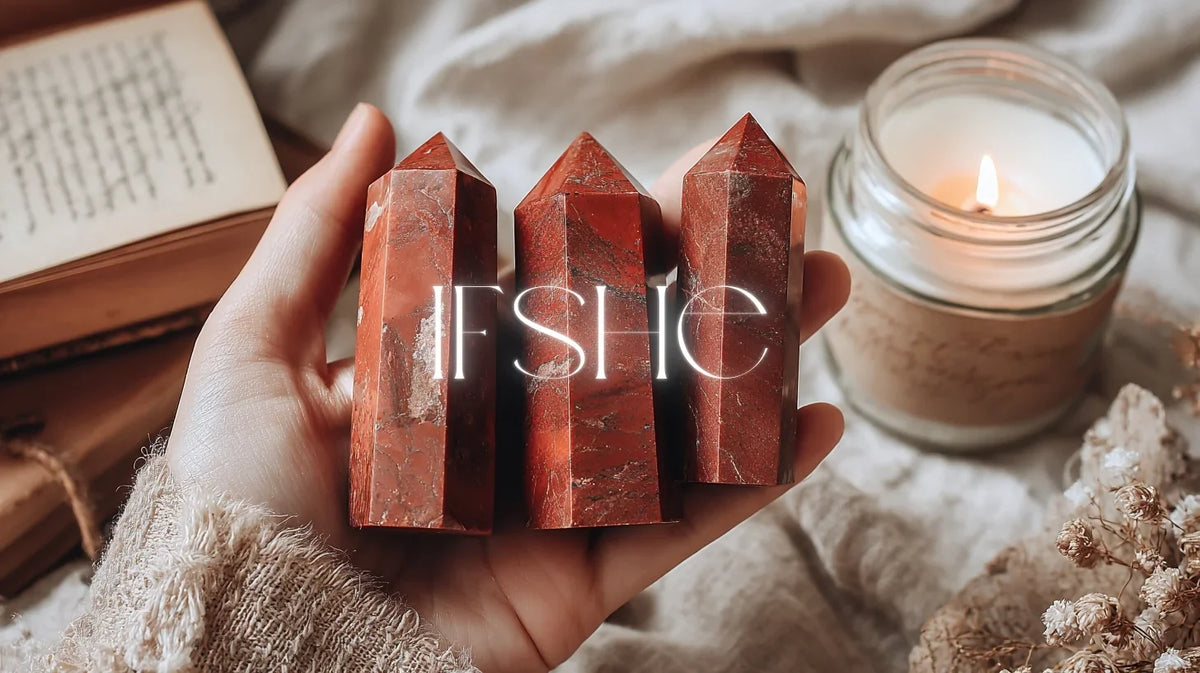
What Is the Purpose of a Crystal Point?
|
Time to read 7 min
|
Time to read 7 min
IN THIS ARTICLEIN
Out in the wild, quartz, amethyst, calcite, and other minerals can grow into column-like “terminations”, ending in one or more naturally faceted tips. These pristine growths are known as natural points . A single termination occurs when just one end culminates in a peak; a double termination forms two opposing peaks, like a needle poised to stitch energy through space.
Lapidaries also polish rough material into artificial points. The geometry may be crafted by human hands, yet the internal lattice remains unchanged, so the stone still channels light and pressure in predictable ways.
Ancient Egypt – Quartz and calcite wands appear in tomb art and medical papyri, where priests directed life-force ( heka ) along the patient’s meridians (Papyrus Ebers, c. 1550 BCE).
Classical Greece – Theophrastus described rock crystal as “permanently frozen ice”, prized for engraving seal stones and igniting sacred fires via reflected sunlight (On Stones, 315 BCE).
Meso-America – Obsidian blades shaped into precise points served both as surgical tools and as portals for divination; Aztec priests gazed into the reflective apex to commune with the god Tezcatlipoca (Codex Borgia, 15th c.).
Across continents and millennia, the idea recurs: a pointed stone acts as both tool and conduit for something beyond everyday matter.
Silicon and oxygen atoms stack in a tetrahedral network, forming uniform symmetry. X-ray diffraction studies show that stress or charge travels predictably along the c-axis (Bragg, 1914). That axis frequently aligns with the physical length of a natural point, hinting that the outer geometry echoes the atomic layout inside.
Take-away: Science confirms that a crystal point can literally focus mechanical and electromagnetic energy—plausible reinforcement for spiritual claims of focus and amplification.
Write your goal in the present tense on a small card.
Fold it and set a citrine point atop, tip skywards.
Visualise energy climbing the shaft and shooting into the universe like a flare every morning for 21 days.
Clarity vs Inclusions – Clear quartz acts like a pure fibre-optic cable, whereas points with rainbows or veils scatter light into multiple directions. Choose laser-like clarity or gentle diffusion according to your purpose.
Size & Hand Feel – A palm-sized point is brilliantly versatile for meditation; larger towers excel at room-clearing. There’s no rule that bigger is automatically better—only what feels empowering in your hand.
Termination Style – Double terminations link two chakras or two people, as energy can flow both ways. “Channel” or “transmitter” points have specialised facet angles for advanced work.
Ethical Sourcing – Seek miners or sellers who can trace origins and minimise ecological impact. A point meant for healing gains resonance when its path to you avoided exploitation.
If you’d like to dig deeper, read this comprehensive in-depth guide on crystal point meanings and healing benefits. When you’re ready to invite a point into your own space, browse the curated Crystal Points Collection, or have a leisurely wander through the broader treasure trove on the IFSHE homepage for more gems and inspiration.
Running Water – Hold the point under a cool tap (or a gentle stream if you’re lucky enough to live near one) to rinse away surface dust and residual static charge.
Moonlight Bath – Leave it on a windowsill during a full-moon night to reset energetic patterns; British skies may be cloudy, but the moon’s pull works through them.
Sound Clearing – A singing bowl’s vibration realigns the atomic lattice, similar to demagnetising a compass needle.
Mindful Storage – Wrap points in a natural-fibre cloth to prevent chipping that could blunt the termination’s focus.
Myth: “A chipped point is useless.”
Reality: Minor chips alter optical symmetry but don’t delete piezoelectric properties. You can still work with the stone; simply recalibrate your intention to embrace its new geometry.
Myth: “Only quartz points conduct energy.”
Reality: Tourmaline, topaz, and even sugar crystals exhibit piezoelectricity. Quartz is popular because it’s abundant and robust.
Myth: “Science dismisses crystal healing.”
Reality: While rigorous clinical evidence is limited, materials science validates energetic behaviours—electric fields, pressure currents—that underlie many metaphysical claims. The subjective benefit depends on your engagement and expectation.
Balancing wonder with critical thinking lets you enjoy the best of both worlds.
Q: Does the direction of the point really matter?
A: Yes. Measurements show charge density increases towards the apex, so orientation influences the flow you feel.
Q: Can I use one point for multiple intentions?
A: Absolutely—just cleanse it between uses (running water or sound) and restate your new purpose so the lattice “remembers” fresh data.
Q: Are lab-grown quartz points as effective?
A: Their lattice is virtually identical and they exhibit the same piezoelectric curve. Spiritually, it comes down to personal preference.
Q: How often should I cleanse my point?
A: After any intense session or roughly once a month. Consider it akin to rebooting a computer to clear background processes.
Q: Can children work with crystal points safely?
A: Yes, under supervision. Choose larger, less breakable stones and frame activities as playful exploration rather than rigid ritual.
A crystal point is more than a pretty arrow of stone—it’s a meeting place where physics and philosophy converge, where silicon symmetry echoes the straight-line resolve in your own mind. Next time you hold one, pause and ask: What single idea am I ready to aim into the world? Your answer, guided by that gleaming tip, might just point you towards your next great adventure.